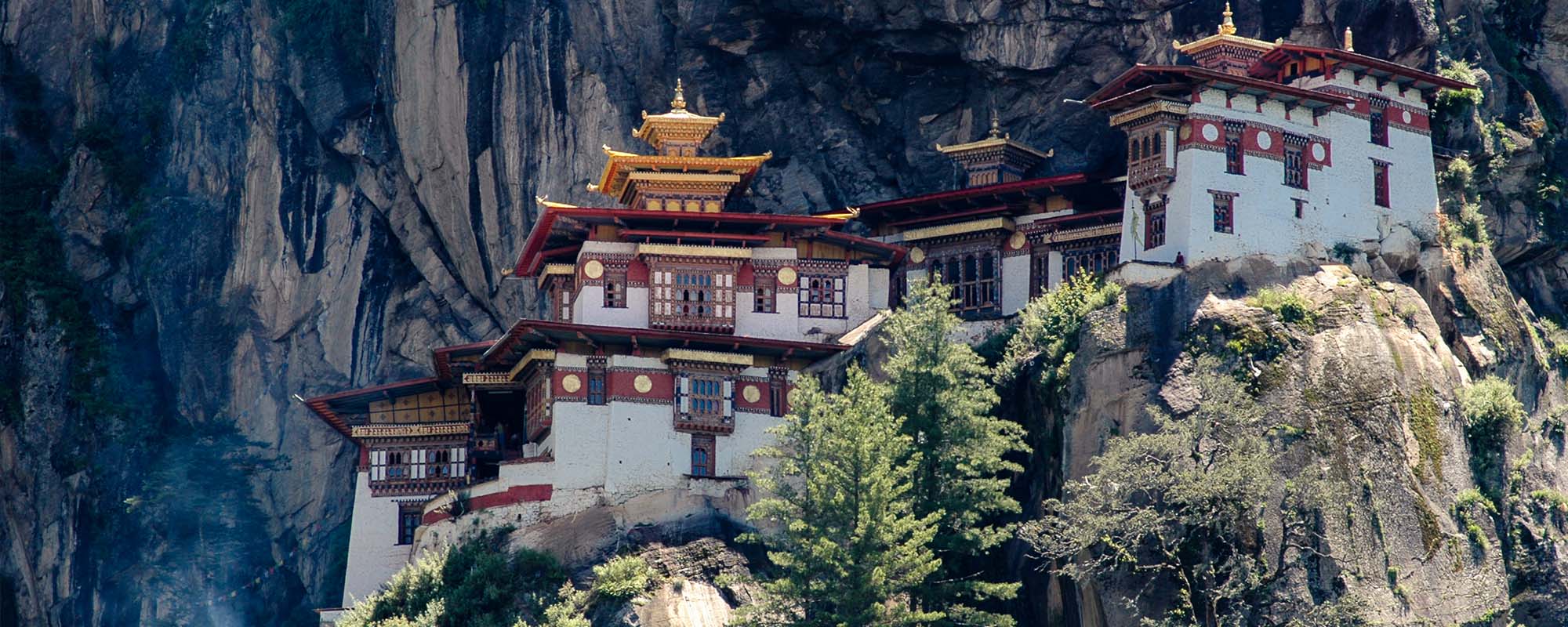
Day 1: Arrival Paro International Airport, transfer to Thimphu
Distance: 53Kms / 32miles
Drive Time: 1 hour approx.
Altitude: 2,350m / 7709ft
On arrival to Paro international airport, our representative will welcome you and drive you to your hotel in Thimphu, the capital city of Bhutan. The drive takes you through the picturesque winding road along the Paro River.
After settling into your hotel, the day in Thimphu offers many options to explore the culture, religion and beautiful forests of the bustling capital:
Taschichho Dzong means the ‘Fortress of Glorious Religion’ named by Zhabdrung in 1641. The fortress serves as the office of the King, ministers and various government organizations.
Changangkha Lakhang, the popular temple is visited every day by many Bhutanese parents in particular to obtain an auspicious name for their newborn or blessing for their young children from the protector deity Thamdrin.
Pangri Zampa is the school of traditional astrology in Thimphu founded in the 16th century by Zhabdrung Ngawang Namgyal. This institute releases the Bhutanese calendar every year and also decides dates for important national events of the Kingdom.
Cheri Goemba, the first Buddhist monastic school started by Zhabdrung in 16th century which now serves as the mediation centre for the higher level Buddhist studies. While nearby Tango Monastery was founded by Lama Gyalwa Lhanangpa in the 12th century, however, the present monastery was built by Drukpa Kuenley, the divine madman. The head lama, a descendant of Lama Drukpa Kuenley presented the Goemba to Zhabdrung. Zhabdrung Rinpoche mediated in a cave nearby.
Zangtho Pelri Lhakhang is said to represent the celestial abode of the Guru. The privately owned chapel was built in the 1900s by Dasho Aku Tongmi, the musician who composed Bhutan’s National anthem. The Lhakhang offers an excellent view of surrounding area.
Traditional Paper Making factory also known as Jungshi Handmade Paper Factory. In Bhutan paper is mainly made from the bark of the Daphne bush. You can see the entire process, from soaking to drying and it takes three days to produce one sheet of paper.
National Textile Museum was inaugurated in 2001 by her Majesty Gyalum (Queen Mother) Sangay Choden Wangchuck. With the aim to preserve and promote this living art, the Royal Textile Academy of Bhutan was instituted in May 2005 as a non-government, nonprofit organization. It showcases some of the best royal dresses and crowns with a brief introduction about Bhutan’s Kings.
Gagyel Lhundrup Weaving Center is privately owned centre at the south end of Thimphu, Bhutan’s finest fabrics are produced in a simple one-story workshop. They have a selection of hand-woven textiles, cloth and ready-made garment for sale.
In addition to the above optional visits, your program can be tailored to include any of the easy to challenging hikes that take you up into the mountains or national park, to remote monasteries or simply thru rich biodiversity. Other possibilities include visits to lovely little galleries of Bhutanese traditional or modern art and textiles, boutiques for Himalayan artifacts, auspicious worship houses, the Thimphu Zoo, home to Bhutan’s National animal, the Takin or something as simple and incredibly beautiful as sitting amongst hundreds of whispering prayer flags as the sun sets over the valley.
Day 2: Morning in Thimphu and drive to Paro
Distance: 53Kms / 32miles
Drive Time: 1 hour approx.
Altitude: 2,250m / 7382ft
Breakfast in Thimphu and drive to your next valley.
The rich valley of Paro has so much to offer and the valley extends from the confluence of the Paro Chhu and Wang Chhu rivers at Chunzom up to Mt. Jomolhari at the Tibetan border to the north. This region is one of the most picturesque in the Kingdom and is covered in fertile rice fields and has a beautiful, crystalline river meandering down the valley.
Our first stop, the National Museum, which rests above Paro Dzong, is also known as Ta Dzong (watchtower) and was built in 1649 to protect the Paro Dzong. The Paro Dzong’s full name is Paro Ringpung Dzong, which means ‘Fortress on a heap of jewels’ and was constructed in 1644 by Zhabdrung Ngawang Namgyel. Now the Dzong houses both the monastic body and district government offices. From the Dzong, a leisurely walk back into town crosses the scenic Nyamai Zampa (Bridge), a unique model of Bhutan’s traditional cantilever bridges. Continue to the town temples, Tshongdue Lhakhang and Drukchholing Lhakhang, with its fascinating altar and paintings. The wall paintings and unique design of Dungtse Lhakhang, plus a visit to the revered Kyichu Lhakhang, which pins down the left foot of a treacherous Ogress, are a great finish to this day of cultural immersion. Leisure evening at the hotel.
Day 3: Paro
Hiking duration: 4.5 hours
After breakfast, hike to the magnificent Tiger’s Nest combined with lunch at the farmhouse or picnic. Tiger’s Nest or Taktshang Goempa is one of Bhutan’s most revered monuments. It literally hangs off the face of a cliff 900 m above the valley floor. The legend states that Guru Rinpoche flew into Bhutan on a mythical tigress and meditated in a cave before bringing Buddhism to Bhutan. The hike offers spectacular views of the Goempa and the valley below. Horses or mules can be arranged on request to help lighten the journey.
Day 4: International Departure
Departure towards your onward journey.